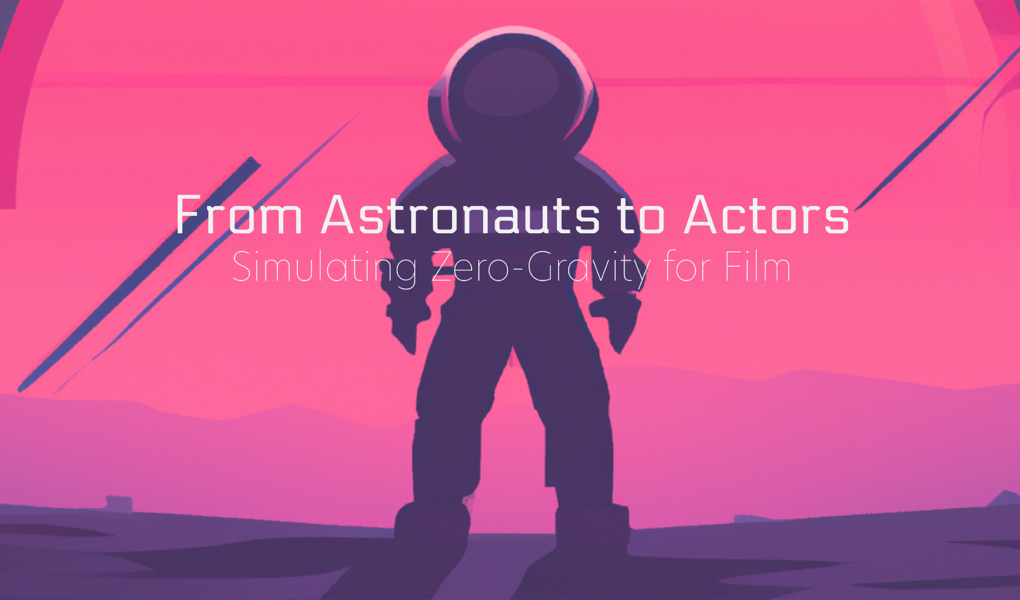Abstract
Space films are often praised for being visually stunning and thought provoking, with a strong emphasis on realism and scientific accuracy. Part of the magic of these films are zero-gravity scenes that add to the immersive experience of the story. Simulating zero gravity is difficult, and the methods used today were inspired by NASA’s previous attempts at training astronauts. This article discusses how zero gravity is simulated for film and how films balance scientific accuracy with logistical implications.
Introduction

Figure 1. A shot of Sandra Bullock in the 2013 film Gravity [1].
We see the inside of the airlock of a space shuttle. Sandra Bullock is struggling out of an astronaut suit. Her labored breathing is a sharp contrast to the deep hum of the background music, the vibrato of the string instruments forming a slow heartbeat. The pieces of her suit scatter through the room, drifting out of sight. Once she is free of the suit, she floats, suspended in the air. Her breathing is calm and relaxed. She is weightless, silently curling into a fetal position, floating in the airlock in zero gravity.
Oh, this article will contain spoilers.
There’s something breathtaking about zero-gravity. It has the capability to be both wonderfully relaxing and terribly frightening at the same time. While it seems fun to be able to experience
weightlessness, that same experience rapidly turns to fear if one has to perform a spacewalk without a tether. These are the aspects of zero-gravity that science fiction films are trying to capture. Some of the most visually stunning scenes in film have come from science fiction movies, primarily those that take place in the vacuum of space.
To capture the heartstopping effects of zero-gravity, filmmakers attempt to portray these scenes as realistically as possible. To do so, they must find a way to simulate zero gravity. Simulating zero-gravity as a whole is a difficult task. Doing so to film scenes for a movie is even more difficult because actors and crew members are not trained to work in a zero-gravity environments. So how do they accomplish the extraordinary scenes that take place in the vacuum of space? As it turns out, it’s pretty similar to how they train astronauts to work on the International Space Station (ISS).
What is Zero Gravity?
In truth, most of what we associate with “zero gravity,” such as satellites orbiting the earth and astronauts aboard the ISS, is not a true zero-gravity environment at all. What most films are attempting to simulate is an infinite freefall referred to as “microgravity,” not “zero-gravity.” When an object is in orbit around the Earth, it is in a constant freefall toward the ground, having enough of a forward velocity that the arc of its fall matches the curve of the Earth. This creates the perception of weightlessness, as the entirety of the system, both the spaceship and the astronauts, is in freefall. Think of Newton’s law of inertia: objects have inertia if they are completely at rest or if they are in a state of constant motion. The space station does not create any reactionary forces on the astronaut, and thus the astronaut is not able to differentiate between being completely at rest or in a state of constant motion [2, 3, 4]. Which is why when referring to orbital mechanics, both the space station and the astronauts experience less than 10-6 g in microgravity. A g is defined as an acceleration equal to the acceleration due to gravity on Earth [5].
Even being on the space station is not perfect microgravity. At 280 km above the surface of the Earth there are still a few oxygen atoms hitting the space station, and the electrical current of the station itself creates some torques, or twisting forces, so there are still some forces acting on the ISS and therefore the astronauts. However, according to former NASA astronaut Garrett Reisman, “… as far as you’re concerned, when you’re up there, it’s perfect.”
The Vomit Comet
Technically, it is possible to achieve something close to actual microgravity by briefly entering the same freefall experienced by objects in orbit. This is achievable through an aircraft following a parabolic flight path, colloquially referred to as a “vomit comet”. The airplane will begin to angle its nose upwards (pitch upwards, once the plane reaches a 45 degree angle, it pitches downward quickly in order to cancel out the acceleration due to gravity in the normal (upward) direction. During this time, the aircraft undergoes 1.8 g of acceleration. At the top of the arc of the parabola, the aircraft and its passengers enter freefall together, experiencing 0 g of acceleration for approximately 25-40 seconds [2, 3, 4].

Figure 2. Diagram of flight trajectory [2]
This is how astronaut candidates are introduced to the experience of zero-gravity. They have fun floating around, getting used to what microgravity aboard the ISS feels like. Before the plane pitches up again, the pilot calls out a warning, and they lie flat on the ground while they undergo the 1.8g. Compared to months in actual microgravity, the experience pales in comparison. Dr. Reisman describes the experience as, “never perfect in the airplane, you’re always drifting a little bit towards the ceiling or towards the floor or to the side or something. It’s never perfect microgravity. Also it only lasts for thirty seconds so there’s a limit to what you can do.”
Underwater Training
After astronauts are introduced to the feeling of zero gravity through the vomit comet, their training is primarily organized around spacewalks. While inside the ISS, the crew has access to handrails and foot restraints. Outside the station, they need to be able to operate efficiently in a zero gravity environment. Due to the short duration of zero gravity in the vomit comet, it does not allow for spacewalks to be simulated. The majority of training for future astronauts actually occurs in a pool approximately 200 feet long, 100 feet wide, and 40 feet deep. It is large enough to fit the entirety of the ISS, or in the case of training, full-scale models of the real thing.
When speaking to Dr. Reisman, he described how the astronauts put on training suits similar to the space suits they would use in an actual spacewalk. The astronaut candidates are then lifted by a crane into the water, where they float. Weights and floats are placed into hidden pockets all over the suits, allowing for the astronaut to remain suspended at a specific depth in the pool. In Dr. Reisman’s experience “… they very carefully balance you.. So you are truly neutrally buoyant.” The astronauts are then able to move around using tethers and handholds placed outside of the ISS in order to simulate spacewalks.
Faking It for Film
The vomit comet is the closest you can get to true microgravity while on Earth, making it an appealing option for filmmakers attempting to achieve the most realistic zero-gravity scenes possible. However, it is not the most efficient method. If 25 seconds sounds like a woefully short amount of time to experience microgravity, that’s because it is. Additionally, there are not many vomit comets currently in use. The most popular zero-gravity aviation company filmmakers can work with is Zero-G, which uses a modified Boeing 727, a once common commercial airplane model that was retired in 2019. The small space inside the Boeing 727 is not ideal for set-builders to modify in order to make it seem like different parts of a spaceship. Lastly, experiencing this parabolic flight path commonly makes untrained individuals, such as actors and crew members, nauseous – it’s called a “vomit comet” for a reason. So, filmmakers have to find a better way to fake the appearance of zero-gravity.
That’s not to say it’s impossible to film a movie in a vomit comet. In spite of the complications, many films have used vomit comets in order to film zero-gravity scenes and to give actors something to reference when shooting on the ground. Most famously, much of the 1995 film Apollo 13 was filmed onboard NASA’s KC-135, one of the first aircraft models to be used for performing a zero-gravity maneuver. The filmmakers broke down each scene into small chunks in order to film each part in just 25 seconds.When they had finished, the actors and the film crew had flown a total of 612 parabolas, totaling about four hours of weightlessness. There was a learning curve with this process, to say the least. But eventually, both the actors and the crew members adapted to the environment, learning how to brace themselves during each parabola before they hit the ground at 1.8 g [6].
This decision for Apollo 13 was groundbreaking and inspired other filmmakers to adopt a similar practice for their movies. The airplane scene in The Mummy starring Tom Cruise was also filmed in a vomit comet [7], as was an episode of The Apprentice, and a segment on Mythbusters [8].
Similarly, the zero gravity scenes in Alfonso Cuarón’s 2013 film Gravity were filmed in conditions similar to how astronauts train underwater. The actors were connected to a 12-wire suspension system and pulled along according to the scene [9]. This method has benefits similar to that of the vomit comet. While in the suits, the actors are neutrally buoyant and therefore appear to float in place with any force sending them into a state of perpetual motion. The drawback to this method is that actors move much slower than they would in actual zero-gravity. Additionally, it is more difficult to film scenes without suits as there are no places to hide the weights that keep the actors buoyant.
However, most zero-gravity scenes are filmed in a much simpler, much cheaper way. The most common method of simulating zero-gravity on a film set is to put the actors in a harness. Wires can then connect to the harness and lift the actors into the air, where they spend much of the scene in front of a green screen. This essentially means the actors are being puppeted by the wires during the filming process. The background is then digitally added in post production. This is the method primarily used in the 2015 film The Martian. They had their stunt team suspended from an overhead winch system, and programmed the winches, camera, and set to all move at the same time to create the exact scene created in the previsualization. This ensured that every scene was shot the exact same way, and the actors and camera could move easily through the set without bumping into anything [10].
Another common method of filming is to build sets vertically rather than horizontally in order to achieve the right angle for a shot. For example, the famous hallway scene in Christopher Nolan’s Inception was filmed in this way. The set for the hallway was built vertically, so when the actors were suspended upright, they appeared to be floating sideways.

Figure 3. A computer generated scene in For All Mankind [11]
Computer Generated Imagery (CGI) and digitally generated scenes have also become far more prevalent in film. In the case of complex scenes involving spacesuits, which can be difficult to move in, sometimes the entirety of the scene is digitally engineered rather than physically filmed. This is accomplished by placing the actors in a green screen box that has internal lighting to match the lighting of the scene. This is referred to as a Light Box. The Light Box could project images of Earth and space and have small cameras programmed to capture the close ups needed with the proper lighting. Only the actor’s faces are filmed and superimposed into a digital scene. This was used extensively in Gravity and For All Mankind for any external scenes such as spacewalks [9, 12].
What Comes Next?
All of these attempts at faking zero-gravity fall flat when compared to the real thing. This leaves one big question, how do we move forward from here? What are the next steps at making zero-gravity scenes as realistic as possible? The simple answer is by sending film crews into space for real.
This solution is not nearly as far off as it may seem, in 2021 we have already started to see the beginning of private missions up to the space station. In fact, Axiom recently partnered with the United Kingdom-based production company Space Entertainment Enterprise (SEE) to begin building a soundstage in space. The module would be the first of its kind, purely designed for entertainment purposes. Tom Cruise is slated to be sent to the station to film his upcoming movie which is set in space [13]. Not many details have been released about the project so far, but there is sure to be news in the near-future as construction of the new soundstage begins.

Figure 4. An artist’s rendition of the Axiom and SEE space station [13].
It’s important to remember that realism cannot be the biggest concern for movies. In the words of Dr. Reisman, “At the end of the day, if it’s between something important to the plot, and something that is important to the laws of physics, the plot is going to win. And that’s okay, it should. It’s not a documentary, it’s a drama, and it’s a story. And the important thing is how good of a story it is.”
References
[1] L. Cabrera, “Isolation, rebirth, and the motif of the fetal position,” Sweet Perspective, 19-Oct-2020. [Online]. Available:
https://www.sweetperspective.com/home/2020/10/18/isolation-rebirth-and-the-motif-of-the-fetal position. [Accessed: 03-May-2022].
[2] F. Karmali and M. Shelhamer, “The dynamics of parabolic flight: Flight characteristics and passenger percepts,” Acta astronautica, Sep-2008. [Online]. Available:
https://www.ncbi.nlm.nih.gov/pmc/articles/PMC2598414/. [Accessed: 20-Jan-2022].
[3] M. W. Kathleen, “On board the vomit comet,” The Science Teacher, vol. 67, (2), pp. 22-26, 2000. Available:
http://libproxy.usc.edu/login?url=https://www.proquest.com/scholarly-journals/on-board-vomit-c omet/docview/214627709/se-2?accountid=14749.
[4] N. T. Tillman, “Vomit comet: Training flights for astronauts,” Space.com, 25-Aug-2017. [Online]. Available: https://www.space.com/37942-vomit-comet.html. [Accessed: 20-Jan-2022].
[5] “Dictionary of technical terms for aerospace use ,” NASA. [Online]. Available: https://er.jsc.nasa.gov/seh/g.html#:~:text=An%20acceleration%20equal%20to%20the,measurem ent%20for%20bodies%20undergoing%20acceleration. [Accessed: 20-Jan-2022].
[6] C. Siede, “On Apollo 13’s 20th anniversary, a look at how they made the film so realistic,” The A.V. Club, 23-Aug-2017. [Online]. Available:
https://www.avclub.com/on-apollo-13-s-20th-anniversary-a-look-at-how-they-mad-1798281369. [Accessed: 20-Jan-2022].
[7] P. Sciretta, “The mummy airplane sequence was shot in the vomit comet,” SlashFilm.com, 05-Dec-2016. [Online]. Available:
https://www.slashfilm.com/548012/the-mummy-airplane-sequence/. [Accessed: 20-Jan-2022].
[8] B. Bryant, “The secrets of Hollywood stunts in the ‘vomit comet’,” Pressreader.com, 01-Jul-2017. [Online] [Accessed: 3-May-2022]
[9] “Movie tech: How ‘gravity’ threw Sandra Bullock into zero gravity,” NBCNews.com, 04-Oct-2013. [Online]. Available:
https://www.nbcnews.com/sciencemain/movie-tech-how-gravity-threw-sandra-bullock-zero-grav ity-8c11326787. [Accessed: 20-Jan-2022].
[10] A. Wasley, “The Martian’s VFX supervisor on creating zero gravity without a ‘vomit comet’,” Motion Picture Association, 28-Oct-2015. [Online]. Available:
https://www.motionpictures.org/2015/10/the-martians-vfx-supervisor-on-creating-zero-gravity-w ithout-a-vomit-comet/. [Accessed: 20-Jan-2022].
[11] I. Failes, “Zero-gravity frame rates, deep fakes and Moon Scrapes: The vfx of ‘for all mankind’,” befores & afters, 23-Apr-2021. [Online]. Available:
https://beforesandafters.com/2021/04/23/zero-gravity-frame-rates-deep-fakes-and-moon-scrapes the-vfx-of-for-all-mankind/. [Accessed: 03-May-2022].
[12] Anonymous (Dec 04). Below the Line: Making ‘Gravity’. Available:
http://libproxy.usc.edu/login?url=https://www.proquest.com/blogs-podcasts-websites/below-line making-gravity/docview/2213972786/se-2?accountid=14749.
[13] M. Sheetz, “Tom Cruise space movie producers sign deal with Axiom to build studio in orbit,” CNBC, 20-Jan-2022. [Online]. Available:
https://www.cnbc.com/2022/01/20/tom-cruise-movie-producers-sign-axiom-deal-for-space-prod uction-studio.html. [Accessed: 04-Feb-2022].
Key Search Terms
space, film, movies, zero gravity, vomit comet
Links for Further Reading
https://www.ncbi.nlm.nih.gov/pmc/articles/PMC2598414/
https://www.space.com/37942-vomit-comet.html.
https://www.avclub.com/on-apollo-13-s-20th-anniversary-a-look-at-how-they-mad-1798281369



